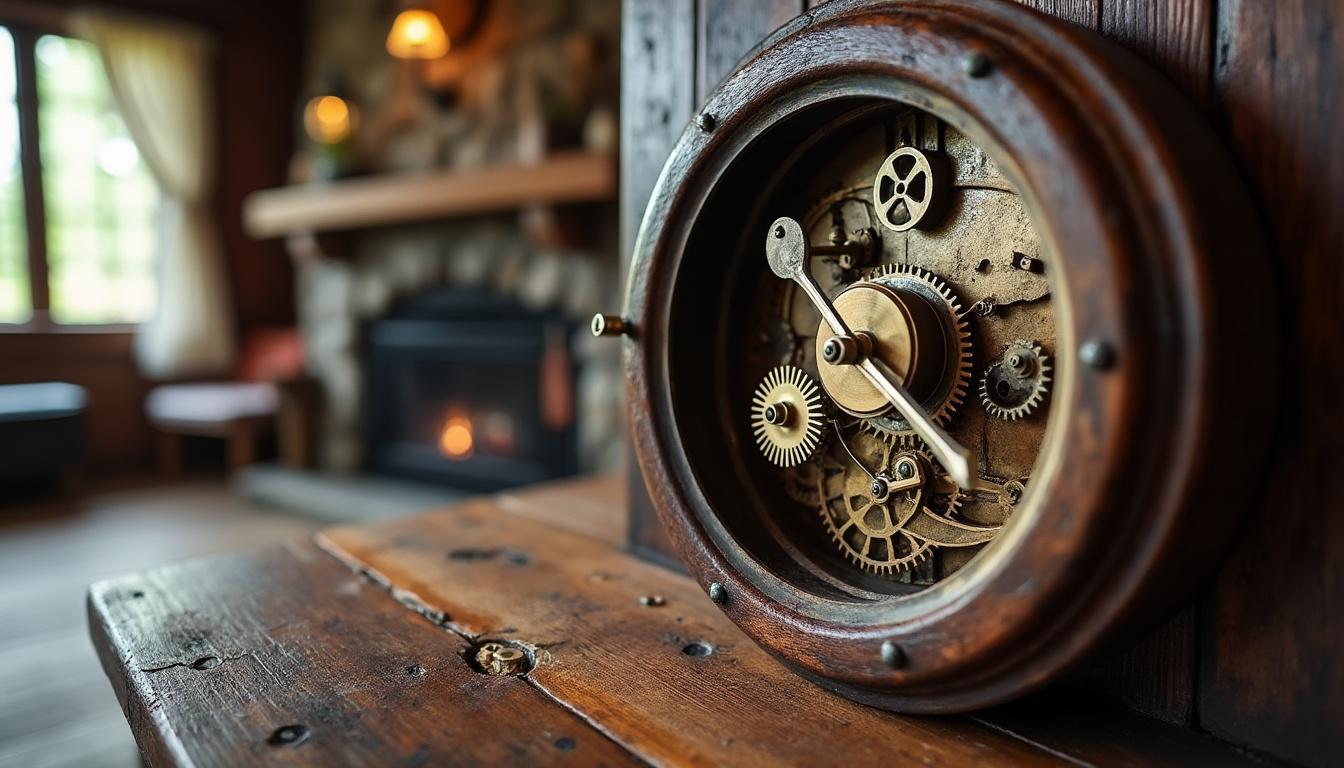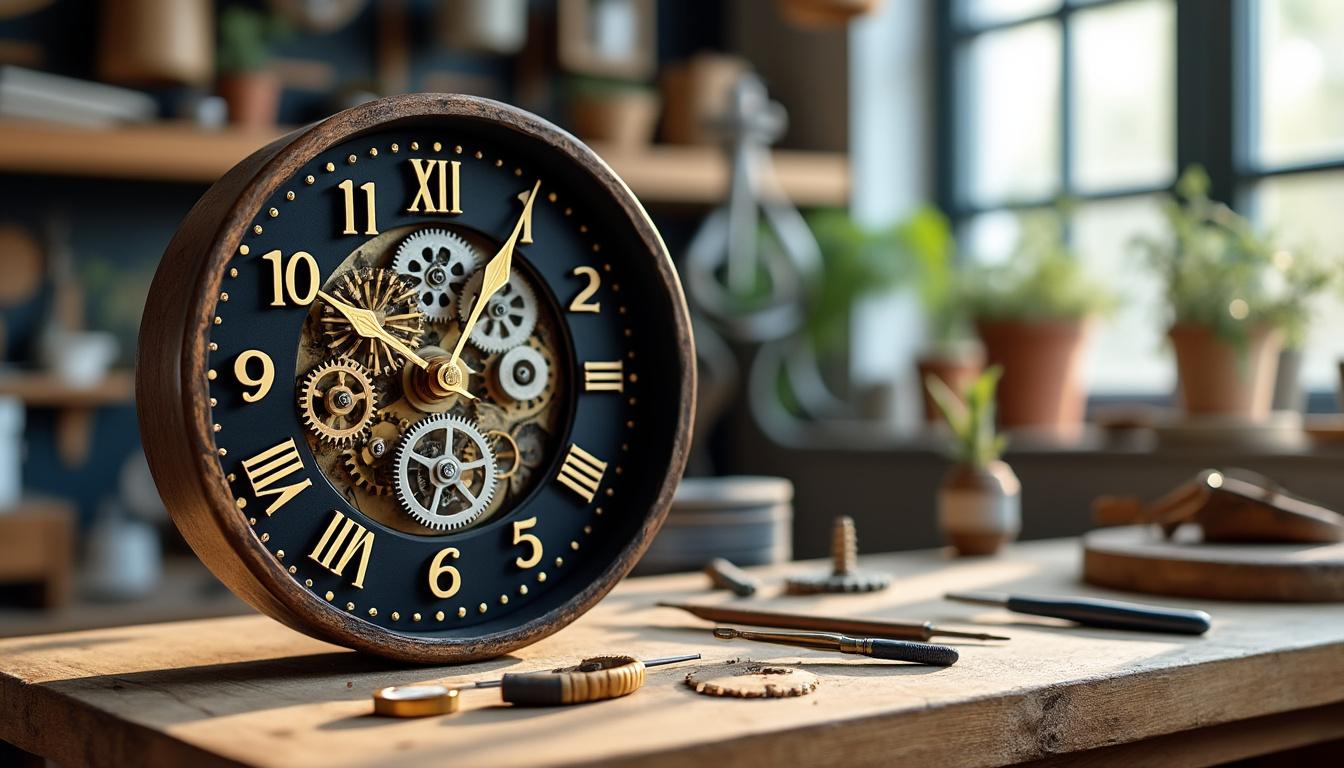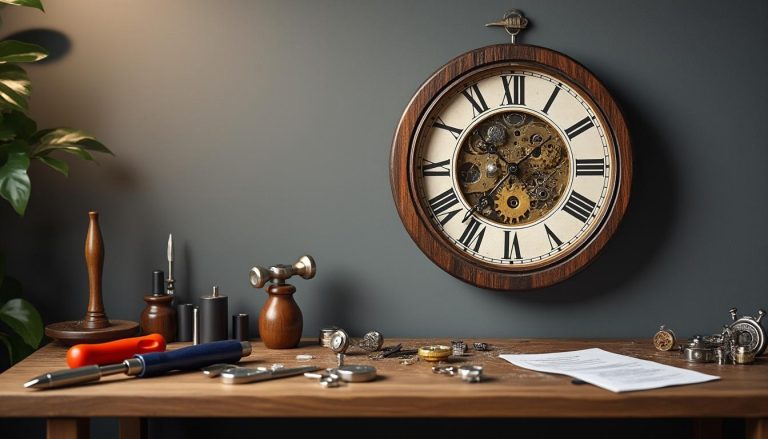Wall clocks are timeless pieces that blend functionality with style, often serving as focal points in Canadian homes. However, when the heart of the clock—the mechanism—starts to falter, it can be frustrating. What if that classic Howard Miller or the sleek Citizen wall clock in your living room suddenly loses its rhythm? Fear not! Replacing the mechanism is far simpler than you might expect. Whether you prefer a quiet Seiko movement or the dependable tick of a Bulova, this guide equips you to breathe new life into your timekeeper without having to dash to a specialty store in Toronto or Vancouver. From the tools you’ll need to troubleshooting quirks unique to each brand like Rhythm or Hermle, we’ve got you covered with clear, practical steps that even a beginner can follow—with a little patience and a sprinkle of Canadian ingenuity. Let’s get those hands moving again, eh?
Understanding the Basics: What Makes a Wall Clock Mechanism Tick in Canada?
Before you dive into the nuts and bolts of replacing a wall clock mechanism, it’s important to grasp the inner workings of these devices. Wall clock mechanisms, whether from well-known manufacturers like Casio or the luxury watchmakers at Chopard, are all about precision engineering wrapped in a compact package. The central components include tiny gears and springs that transfer energy to move the hour, minute, and sometimes second hands.
Here’s a breakdown of common types and parts you’ll encounter:
- 🔧 Quartz Movements: Powered by batteries, these are the most common in Canadian homes due to their accuracy and low maintenance.
- ⚙️ Mechanical Movements: These require winding and are more intricate, often found in premium clocks by Hermle or Howard Miller.
- 🔋 Power Source: Most modern Canadian wall clocks, like those from Timex or Groz, use AA batteries, but some may have plug-in options.
- 🎨 Hands and Face: The visual interface is crucial for style, and sometimes hands are brand-specific, which can affect replacements.
Understanding these basics helps you make informed decisions when testing and ordering a replacement mechanism compatible with your clock.
| Mechanism Type ⚙️ | Common Brands 🔥 | Power Source 🔋 | Typical Use in Canada 🏡 |
|---|---|---|---|
| Quartz Movement | Seiko, Citizen, Bulova | Battery (AA Mainly) | Daily home clocks, offices, schools |
| Mechanical Movement | Hermle, Howard Miller | Manual Wind or Weight | Antique clocks, heirlooms |
| Electric Movement | Casio, Rhythm | Plug-in Power | Specialty modern designs, silent workplaces |

Spotting When Your Wall Clock Mechanism Needs Replacement
Nobody wants their prized wall clock, perhaps a prized Chopard replica or a vintage Timex model, to stop keeping accurate time. But how do you tell the difference between a minor hiccup and the need for a full mechanism swap? Here are key signs that suggest it’s time to yank out the old and install fresh mechanics:
- ⏰ Consistently Inaccurate Time: If your clock is always running ahead or behind despite adjustments, it often indicates wearing gears in the mechanism.
- 🔇 Loud or Irregular Sounds: Excessive ticking, grinding noises, or other unusual sounds can signal internal deterioration.
- 🛑 Stuck or Sluggish Hands: When the second hand, or even the minute/ hour hands, hesitate or freeze, the movement inside is likely damaged.
- 💥 Visible Damage: This includes broken gears, warped parts, or corrosion—unfortunately common in Canadian homes exposed to humidity during winter months.
It’s also wise to test your clock outdoors briefly or near well-working clocks like a Casio digital model or a Citizen wristwatch to verify time drift isn’t due to external factors. Observing patterns will help you decide whether the mechanism needs replacement or just a tune-up.
| Warning Signs 🚩 | What It Means 🕵️♂️ | Recommended Action ✅ |
|---|---|---|
| Clock runs too fast or slow | Gears slipping or spring tension lost | Plan for mechanism replacement |
| Loud ticking/grinding | Worn or broken internal components | Remove mechanism for inspection |
| Hands stall or won’t move | Physical obstruction or seized gears | Clean and test; replace if persistent |
| Corrosion or visible damage | Exposure to humidity or impact | Replace and consider protective casing |
Essential Tools and Materials to Replace Your Wall Clock Mechanism
Canadian homeowners and DIY enthusiasts will be pleased to know that wall clock mechanism replacement rarely demands complex or costly tools. Most can be found in your toolbox or bought easily from Canadian chains like Home Depot, Canadian Tire, or Lee Valley. Here’s the quick shopping list of what you’ll need:
- 🪛 Screwdrivers: Both flathead and Phillips, depending on your clock screws.
- 🔗 Pliers and Tweezers: For gently removing hands and handling small parts.
- 🕰️ Replacement Mechanism: Ensure compatibility by measuring your old mechanism’s shaft length, mounting holes, and power source type. Brands like Seiko, Howard Miller, and Bulova offer reliable replacements widely available online and in stores.
- 🛢️ Lubricating Oil: Clock oil or sewing machine oil works well for smooth operation.
- 🧤 Optional Work Gloves: For extra grip and protection during the process.
- 🧻 Soft Cloth or Towel: To protect the clock face and your workspace.
Buying from Canadian retailers ensures you get mechanisms that conform to local standards and warranties, plus quick returns if the replacement doesn’t fit perfectly. It’s also worth comparing products from trusted brands like Rhythm or Casio for silent and accurate ticking options.
| Tool or Material 🛠️ | Purpose 📝 | Estimated Cost in CAD 💸 | Typical Retailer in Canada 🏪 |
|---|---|---|---|
| Screwdriver Set | Remove and install mechanism screws | $15 – $30 | Canadian Tire, Home Depot |
| Tweezers & Pliers | Handle delicate clock parts | $10 – $20 | Lee Valley, Mastercraft |
| Replacement Mechanism (Quartz) | New movement to replace old or damaged one | $10 – $45 | Amazon.ca, specialty clock shops |
| Lubricating Oil | Keep gears running smoothly | $5 – $15 | Pharmacies, Home Depot |
| Soft Cloth | Protect clock face | $5 | Dollar stores, Home goods |
Detailed Step-by-Step Process to Replace a Wall Clock Mechanism Like a Canadian Pro
Ready to roll up your sleeves? Here’s how to switch out your clock’s mechanism carefully and methodically, ensuring your beloved timepiece ticks like new again.
- 🪑 Set up a Clean Workspace: Pick a well-lit table, cover with a soft towel to prevent scratches on the clock face.
- ✋ Remove the Clock Hands: Use tweezers or just your fingers to gently lift the second hand first, then the minute and hour hands. Varying brands like Bulova or Chopard might use different fittings, so be gentle.
- 🔩 Unscrew the Old Mechanism: Flip the clock and locate screws fastening the mechanism. Carefully unscrew, keeping track of them for reassembly.
- 🔌 Disconnect Power: If your clock is battery-powered (Seiko and Citizen often are), remove batteries. For plug-in mechanisms, unplug safely.
- 🆕 Fit the New Mechanism: Align the new mechanism with mounting holes. Sometimes, as Diane from Di’s Studio Designs found with her thrift store clock, brackets may need adjusting or even gluing—just ensure the fix is secure but non-damaging.
- 🔗 Reconnect Hands: Replace the hour hand, then the minute, finally the second hand, making sure none overlap or bend and block movement.
- 🛠️ Test Your Work: Insert fresh batteries or plug power back in. Observe for any hiccups—adjust if hands are sticking or timing seems off.
- 🧼 Clean Up: Wipe the face gently with your cloth and apply a drop of lubricating oil onto moving parts to keep it ticking smoothly.
- 🏠 Mount and Enjoy: Hang your clock securely back on your wall, perhaps near your favorite Groz wall calendar or by the window to admire the handiwork.
This process not only saves money compared to professional repairs—usually running between $50 and $150 in Canadian shops—but also deepens your appreciation for the craftsmanship in your timepiece.
| Step 🔢 | Action 🛠️ | Tips for Canadian Clocks 🍁 |
|---|---|---|
| 1 | Prepare workspace and materials | Work near a window for natural light and ventilation |
| 2 | Remove clock hands carefully | Note Brands: Timex hands can be fragile; apply gentle pressure |
| 3 | Remove old mechanism | Keep screws organized to avoid loss |
| 4 | Disconnect power source | Remove batteries safely and recycle |
| 5 | Fit new mechanism | Check fit carefully; some mechanisms like Rhythm might need slight adjustments |
| 6 | Reassemble hands | Test hand alignment before securing |
| 7 | Test clock function | Reset time, watch for any sticking |
| 8 | Clean and lubricate | Use minimal oil to avoid attracting dust |
| 9 | Mount clock back and enjoy | Choose a location free from direct moisture or extreme temperature changes |
Troubleshooting and Tips: When Things Don’t Go As Planned in Your Clock Repair Journey
Even the best-prepared Canadian DIYer may hit a snag or two. Don’t let a broken bracket or misaligned hands scare you off! Diane M. Lilly’s experience with gluing a bracket on a thrift store clock is a great example of practical problem-solving at home in Newfoundland. Here are some common hiccups and how to fix or avoid them:
- 🧩 Bracket Doesn’t Fit: Modern replacement parts may be slightly bigger than old ones—consider gentle trimming or expert-approved gluing methods, but avoid damage to original clock frames.
- 🔄 Stuck Hands: Check for visible obstructions like bent hands; straighten gently with pliers. Ensure the face materials (cardboard or glass) don’t interfere with movement.
- 📏 Incorrect Hand Size: Some buyers find new hands don’t fit the original face. Often, reusing old hands after minor adjustments is the best fix, especially with brands like Seiko or Howard Miller.
- ⚡ Clock Stops Suddenly: Faulty batteries, poor connections, or bent second hands can cause sudden stops. Try swapping batteries or reseating the hands.
When in doubt, reaching out to Canadian clock repair services like “The Clockworks” or visiting local experts in Montreal or Calgary can save time and heartache. They understand local preferences for brands like Bulova or Rhythm and ensure your clock retains its charm and functionality.
| Problem 🆘 | Possible Reason 🤔 | DIY Fix 🛠️ | When to Seek Professional Help 🚨 |
|---|---|---|---|
| Mechanism too large to fit | Replacement part size mismatch | Trim mounting slots or use strong adhesive | If trimming damages clock frame |
| Hands get stuck | Bent hands or face interference | Straighten hands carefully & clear obstructions | Persistent sticking after adjustment |
| Replacement hands too big | Incompatible size | Reuse old hands or order custom ones | Inability to find matching hands |
| Clock stops suddenly | Dead battery or loose connection | Replace batteries & reconnect parts | Electrical issues or mechanical failure |
FAQ
-
How do I know which replacement mechanism fits my clock?
Check for model numbers or measure the shaft length and mounting points. Online Canadian retailers often list compatibility details for brands like Timex and Seiko.
-
Is it safe to replace my clock mechanism myself?
Yes, with basic tools and patience, many Canadians successfully replace quartz mechanisms at home. For expensive mechanical clocks, consider professional assistance.
-
Where can I buy authentic replacement mechanisms in Canada?
Look for authorized dealers via websites like Amazon.ca, or visit specialty stores in cities like Toronto or Edmonton. Stocks from brands including Bulova and Casio are usually available.
-
How much does a typical replacement cost?
Most quartz mechanisms range from $10 to $50 CAD, depending on brand and features like silent sweeping hands—ideal for bedrooms and offices.
-
Can I reuse the old hands or should I buy new ones?
If the old hands are in good shape and compatible, reusing them saves money and keeps your clock’s original look intact. Adjust gently if needed to ensure smooth motion.



